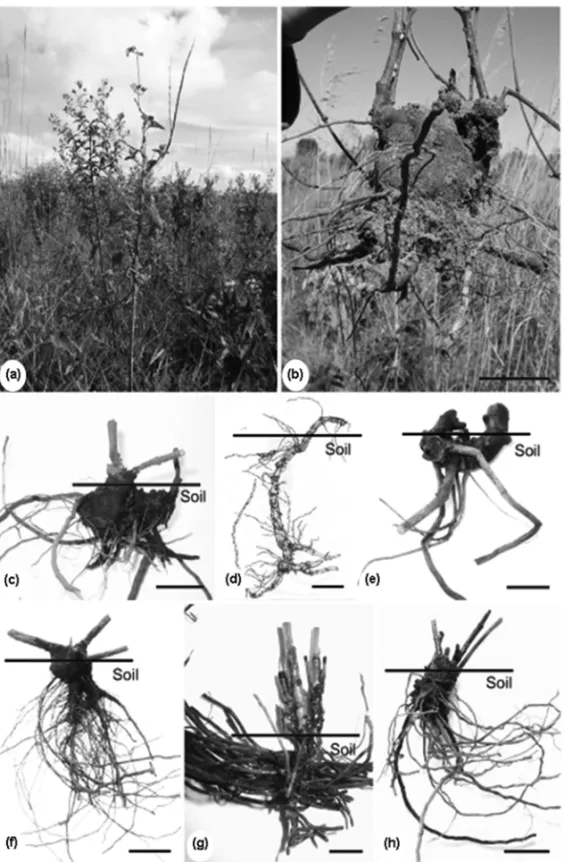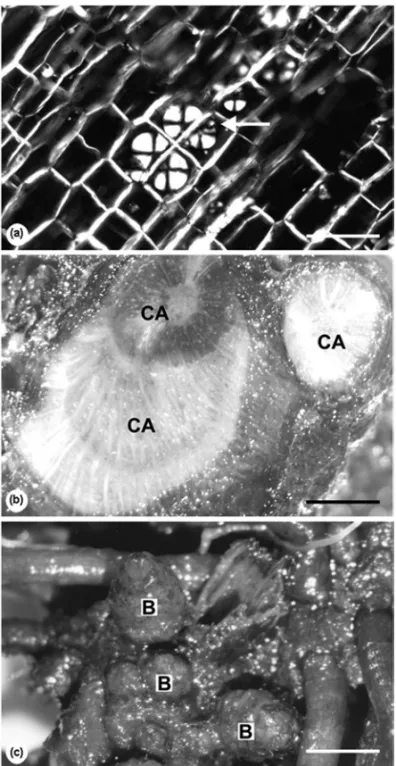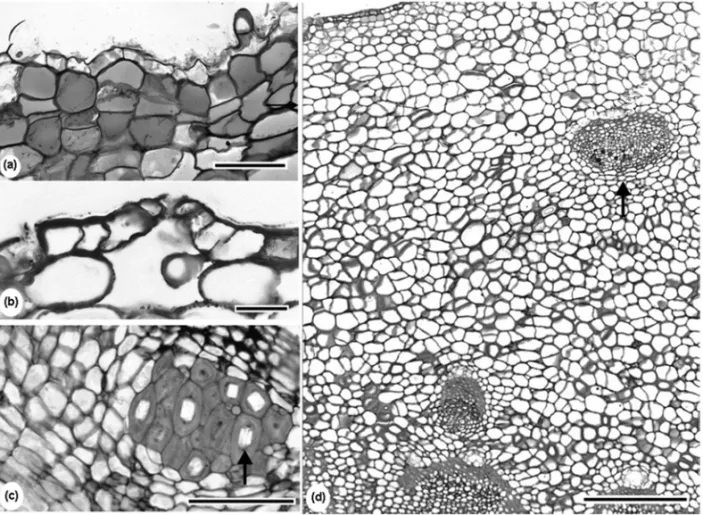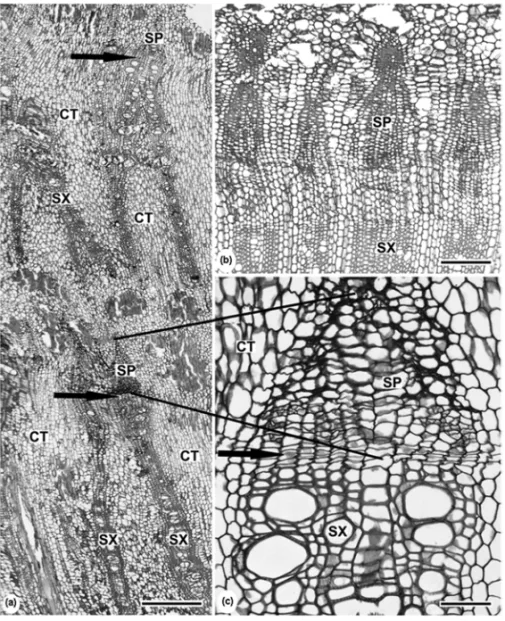(Annals of the Brazilian Academy of Sciences)
Printed version ISSN 0001-3765 / Online version ISSN 1678-2690 www.scielo.br/aabc
Morpho-anatomical features of underground systems in six
Asteraceae species from the Brazilian Cerrado
BEATRIZ APPEZZATO-DA-GLÓRIA1 and GRAZIELA CURY2
1Departamento de Ciências Biológicas, Escola Superior de Agricultura ‘Luiz de Queiroz’, Universidade de São Paulo, Caixa Postal 09, 13418-900 Piracicaba, SP, Brasil 2Departamento de Botânica, Instituto de Biociências, Universidade de São Paulo, Rua do Matão, 277, Cidade Universitária, Butantã, 05508-090 São Paulo, SP, Brasil
Manuscript received on June 8, 2010; accepted for publication on August 24, 2010
ABSTRACT
In the Brazilian Cerrado (neotropical savanna), the development of bud-bearing underground systems as adaptive structures to fire and dry periods can comprise an important source of buds for this ecosystem, as already demon-strated in the BrazilianCamposgrasslands and North American prairies. Asteraceae species from both woody and herbaceous strata have subterranean organs that accumulate carbohydrates, reinforcing the adaptive strategy of these plants to different environmental conditions. This study aims to analyse the morpho-anatomy of underground systems of six species of Asteraceae (Mikania cordifoliaL.f. Willd.,Mikania sessilifoliaDC,Trixis nobilis(Vell.) Katinas, Pterocaulon alopecuroides(Lam.) DC.,Vernonia elegansGardner andVernonia megapotamicaSpreng.), to describe these structures and to verify the occurrence and origin of shoot buds, and to analyse the presence of reserve sub-stances. Individuals sampled in Cerrado areas in São Paulo State showed thick underground bud-bearing organs, with adventitious or lateral roots and presence of fructans. Xylopodium was found in all studied species, except forTrixis nobilis, which had stem tuber. The presence of fructans as reserve, and the capacity of structures in the formation of buds indicate the potential of herbaceous species of Asteraceae in forming a viable bud bank for vegetation regenera-tion in the Brazilian Cerrado.
Key words:anatomy, buds, Compositae, fructans, stem tuber, xylopodium.
INTRODUCTION
The Cerrado vegetation is composed of a mosaic with different physiognomies due to distinct factors, such as deep and well drained soils that are acidic and with high aluminium content, seasonality, with dry periods of 3-4 months, and fire (Coutinho 1982). Species from the herbaceous strata are dominant in open physiognomies (“campos”, grasslands). Plants have seasonal growth: the aboveground biomass dies during autumn, and these species persist as thick underground systems (Filgueiras 2002). During spring and the beginning of rainy sea-son, individuals rapidly resprout and flower using the
Correspondence to: Beatriz Appezzato-da-Glória E-mail: bagloria@esalq.usp.br
de-scribed by some authors for the subtropical grasslands in Southern Brazil (“Campos grasslands” by Fidelis 2008) and the North American prairies (Benson et al. 2004, Dalgleish 2007).
Among the different types of underground sys-tems found in the Cerrado, some can be classified as xylopodium (Hayashi and Appezzato-da-Glória 2007, Appezzato-da-Glória et al. 2008a), tuberous roots, stem-like or radicular difuse system (Alonso and Machado 2007) and rhizophores (Hayashi and Appezzato-da-Glória 2005). The presence of such organs can influ-ence the population dynamics of plant species, since they are able to produce new shoots after the removal of aboveground biomass. According to Kauffman et al. (1994), fire can stimulate the formation of new shoots from buds located in underground organs in the Cer-rado, being thus an important trait for plant persistence after disturbance events (Soares et al. 2006). Recurrent fires can favour especially species with higher capacity of resprouting. After fires, there is an increase in num-ber of species resprouting from buds located in under-ground organs after the death of aboveunder-ground biomass, confirming thus the importance of such bud-bearing or-gans (Medeiros and Miranda 2008, Fidelis 2008).
Verdaguer and Ojeda (2005) associated the impor-tance of the bud bank and the carbohydrate reserves. Reserves of carbohydrates decreased in underground organs during the resprouting phase, as observed by Carvalho and Dietrich (1993) and Portes and Carvalho (2006). According to Hoffmann (1999), in woody spe-cies of Cerrado, plants invest in carbohydrates accumu-lation in underground storage organs, which allow them to rapidly recover after biomass loss caused by fire and assuring, thus, their survival.
Asteraceae plays an important role on the herba-ceous and woody vegetation of Cerrado (Almeida et al. 2005). Several species have thick underground struc-tures with storage reserves, mostly fructans, and a high capacity of bud formation (Tertuliano and Figueiredo-Ribeiro 1993). Fructans are not only sources of carbon, but they also play an important role for plants in envir-onments with water restriction due to their rapid poly-merization and depolypoly-merization reactions involved in osmoregulation processes (Nelson and Spollen 1987, Pontis 1989, Hendry 1993, Figueiredo-Ribeiro 1993,
Talbott and Zeiger 1998, Orthen 2001).
Therefore, this study aims to analyse the under-ground systems of six species of Asteraceae (Mikania cordifolia L.f. Willd., Mikania sessilifolia DC, Trixis nobilis (Vell.) Katinas, Pterocaulon alopecuroides
(Lam.) DC., Vernonia elegansGardner and Vernonia megapotamicaSpreng.) describing their different struc-tural types, verifying the occurrence and origin of shoot buds and, finally, analyzing the presence of reserve substances.
MATERIALS AND METHODS
The species of this study (Mikania cordifolia,Mikania sessilifolia, Trixis nobilis, Pterocaulon alopecuroides, Vernonia elegansandVernonia megapotamica) were
se-lected from surveys in the state of São Paulo (Tertuliano and Figueiredo-Ribeiro 1993, Katinas 1996, Almeida et al. 2005, Ishara et al. 2008), and the criteria of selection was analyzing species of the same genera (in the case of MikaniaandVernonia) and among different genera
(Mikania,Pterocaulon,VernoniaandTrixis), and com-pare the subterranean systems types among them. Adult individuals were collected in natural populations in areas of Cerrado located in Botucatu (22◦53′′S, 8◦29′′W) and Itirapina (22◦13′′S, 47◦54′′W), São Paulo State, Brazil, where Asteraceae is well represented. The vouchers of the specimens (88792, 88791, 92159, 88790, 88787 and 88789, respectively) are deposited in the ESA Herbar-ium, Brazil.
For the anatomical study, underground systems of three adult plants were fixed in FAA 50 (1 part formal-dehyde: 1 part glacial acetic acid: 18 parts 50% ethanol, v/v) for 48 h (Johansen 1940), dehydrated in a graded ethylic series and infiltrated in glycol methacrylate resin (Leica Historesin-LeicaTM– Wetzlar, Germany). Serial
TABLE I
Subterranean type, shoot bud origin and presence of fructans in subterranean systems of six selected species of Asteraceae from the Cerrado. Negative signs indicate
the absence of fructans.
Species Subterranean Shoot bud
Fructans
system type origin Subterranean Root
system
Mikania Xylopodium and
Cambium — Xylem
cordifolia adventitious roots parenchyma ray
Mikania Xylopodium and
Cambium — Cortical
sessilifolia adventitious roots parenchyma
Trixis Stem tuber and
Axillary Cortical Medullary and
nobilis adventitious roots parenchyma cortical parenchyma
Pterocaulon Xylopodium and
Cambium Cortical —
alopecuroides lateral roots parenchyma
Vernonia Xylopodium and
Cambium — Cortical
elegans adventitious roots parenchyma
Vernonia Xylopodium and
Axillary — Medullary and
megapotamica adventitious roots cortical parenchyma
To identify the fructans of the inulin-type, samples of subterranean structures were fixed in 70% ethanol and sectioned by freehand. Inulin crystals were visu-alised under polarised light, and the presence of these crystals was confirmed by a treatment with thymol-sulphuric acid reagent (Johansen 1940).
Photomicrographs were taken with a Nikon Labo-phot microscope or a Nikon SMZ-2T stereomicro-scope. The images were digitally captured with a Leica DMLB microscope (LeicaTM – Wetzlar, Germany) by
using a video camera plugged to a computer utilising the IM50 (LeicaTM – Wetzlar, Germany) software for
image analysis.
RESULTS
All studied species (Fig. 1a-h) had thickened and bud-bearing underground systems (Table I), with or without thickened roots. Additionally, all species accumulated fructans of inulin-type in the parenchyma of adventi-tious roots (Fig. 2a), except for Trixis nobilis, which
also showed fructan accumulation in the thickened un-derground structure, and Pterocaulon alopecuroides,
which accumulates only in the thickened underground structure (Table I).
Based on our anatomical study, we classified T.
nobilis as a stem tuber (Fig. 1e), and the thickened woody axis of underground systems of M. cordifolia,
M. sessilifolia, P. alopecuroides, V. elegans and V. megapotamicaas a xylopodium (Fig. 1b-d, 1f-h).
The size and shape of xylopodia varied among spe-cies (Fig. 1), but a common feature is the self-grafting of the stems basis formed in different development periods (Fig. 2b, 3a, b). Buds could be found spread all over the structure, protected by cataphylls (Fig. 2c), or they were concentrated in the median part of the organ in Pterocaulon alopecuroides. Buds originating
from the cambium of xylopodia could be observed in
M. cordifolia, M. sessilifolia, P. alopecuroides and V. elegans(Fig. 3d, e). Buds located at the upper portion of the stem tuber ofTrixis nobilis and on the xylopodium ofVernonia megapotamicawere axillaries (Fig. 3a, c).
The xylopodia ofM. cordifolia,M. sessilifolia,V. elegansandV. megapotamicawere of stem-like origin,
which was confirmed by the centrifugal development of the primary xylem (Fig. 3f). The xylopodium of
Pterocaulon alopecuroides, on the other hand, was a
radicular structure (Fig. 3g).
Fig. 1 – Adult plant ofMikania cordifoliaL.f. Willd. in its natural habitat (a). General view of the subterranean systems (b-h). M. cordifolia
(b-c).Mikania sessilifoliaDC (d).Trixis nobilis(Vell.) Katinas (e).Pterocaulon alopecuroides(Lam.) DC (f).Vernonia megapotamicaSpreng (g).Vernonia elegansGardner (h). Bars=5 cm (b); 3 cm; (c); 7 cm (d); 2.5 cm (e, f); 1 cm (g); 2 cm (h).
with stomata and trichomes (Fig. 4b). Brachisclereids in the cortex could be observed in all the studie species. In Vernonia elegans and V. megapotamica, prismatic crystals were found in the brachisclereids (Fig. 4c). The underground stem-like axis of Trixis nobilis showed cortical vascular bundles (Fig. 4d).
Mikania cordifolia, the only liana species (Fig. 1a),
Fig. 2 –Vernonia megapotamicaSpreng. Distribution of spherocrystals of inulin (arrow) in parenchyma cells of reserve tissues in the transection of a root (a). Frontal view of the natural self-grafting of the stem-like axis (CA) of xylopodium (b). Shoot buds (B) of the xylopodium (c). Bars
=100µm (a); 2.7 mm (b, c).
habitus, showed vascular cylinders with secondary phloem, cambium and secondary xylem (Fig. 5b).
DISCUSSION
The presence of thickened and bud-bearing underground systems, distributed superficially in the driest portion of the soil in the Cerrado, verified in all studied spe-cies, indicates their importance in storing water and nutrients needed for aboveground sprouting during the
rainy season (Rizzini and Heringer 1961, Appezzato-da-Glória et al. 2008a). In the Cerrado species, the im-portance of fructan reserves in underground structures, as verified in the studied species, is mostly related to regeneration processes of aboveground biomass, flower-ing and plant resistance against water loss (Figueiredo-Ribeiro 1993, Portes and Carvalho 2006, Itaya et al. 2007). Dias-Tagliacozzo et al. (2004) demonstrated that the resistance ofVernonia herbacea(Vell.) Rusby
Fig. 4 – Stem tuber ofTrixis nobilis(Vell.) Katinas with protective tissue constituted by cortical parenchyma cell layers containing phenolic compounds (a) and epidermis with stoma (b). Brachisclereids with prismatic crystals (arrow) in theVernonia elegansGardner xylopodium (c). Cortical vascular bundle (arrow) of theT. nobilisstem tuber (d). Bars=100µm (a, c); 50µm (b); 400µm (d).
in the metabolism of fructans, which favoured the water retention in the rhizophores. In experiments carried out withViguiera discolor Baker (Asteraceae), Isejima et
al. (1991) pointed out that flowering induced indi-viduals to produce a higher content of fructans in tuber-ous roots than in control plants. Carvalho and Dietrich (1993) also verified thatVernonia herbacea, during the vegetative and dormant phases, achieved the highest levels of fructan concentration in underground organs. On the other hand, during the flowering and sprouting phases, the levels of fructan decreased (Figueiredo-Ribeiro et al. 1991).
Xylopodium, as described here for most species, is a common underground organ, being found in more than 90 genera in some Brazilian Biomes (Appezzato-da-Glória et al. 2008a). This structure was described by Lindman (1900) for an underground system that is very common in grasslands of the southern part of Brazil and in the Cerrado Biome, and found more often in plants
Fig. 5 – Transections of the xylopodium ofMikania cordifoliaL.f (a, c). Willd. andMikania sessilifoliaDC (b). Vascular cylinder with successive layers of secondary phloem (SP), cambium (arrows) and secondary xylem (SX), with abundant conjunctive tissue (CT) (a). Vascular cylinder with secondary phloem (SP), cambium and secondary xylem (SX) (b). Detail of the figure (a) (c). Bars=400µm (a,b); 100µm (c).
P. alopecuroides and V. elegans, was also reported by
Vilhalva and Appezzato-da-Glória (2006) and Appez-zato-da-Glória et al. (2008a). Plants with the presence of xylopodia showed seasonal growth and, besides the loss of aboveground biomass during the dry season or destruction caused by e.g. fire, the bases of above-ground shoots and their buds persisted. Therefore, at the upper portion of the xylopodia, stems formed in different development periods naturally graft; more-over, in this portion, buds are axillary like inVernonia megapotamica. The production of stems periodically leading to the formation of a self-grafting structure on the bases of the stem axes is a common feature for xylopodia (Paviani 1987). This phenomenon increases the complexity of this organ and the number of available
buds for sprouting. Therefore, xylopodia play an impor-tant role on the survival and regeneration of the Cerrado species, bearing several viable buds for plant resprouting after disturbance events.
The anatomical structure of xylopodia can be rad-icular, stem-like or both, depending on the analysed species (Appezzato-da-Glória et al. 2008a). The stem-like origin of xylopodium, as described in M. cordi-folia, M. sessilifolia, V. elegansandV. mepapotamica,
has already been observed for some other species, such asIsostigma megapotamicum (Spreng.) Sherff (Aster-aceae) (Vilhalva and Appezzato-da-Glória 2006); rad-icular origin, as described inPterocaulon alopecuroides, was observed for Clitoria guyanensis (Aubl.) Benth
pro-tective tissue, constituted by parenchyma cells filled with phenolic compounds, found in all xylopodia anal-ysed, was also described in rhizomes of Rhaponticum carthamoides(Asteraceae) by Lotocka and Geszprych
(2004). The presence of phenols in these layers is re-lated to the protection against external biotic and abiotic agents (Hutzler et al. 1998). The covering tissue of stem tuber ofTrixis nobilisconsisted of epidermis with stomata and trichomes. Such traits were also described for rhizophores ofSmilax quinquenerviaVell.
(Smila-caceae) by Andreata and Menezes (1999), Vernonia herbaceaandV. platensis(Hayashi and
Appezzato-da-Glória 2005), andOrthoppapus angustifolius
(Appez-zato-da-Glória et al. 2008b). As already proposed by Andreata and Menezes (1999), the presence of stomata and trichomes, including secretory trichomes (Appez-zato-da-Glória et al. 2008b) in underground stem-like systems, suggests the evolution of these stems from an aerial ancestral structure.
Brachysclereids present in the cortex of all studies species regards the sclerophylly common in the Cerrado plants (Rizzini 1997).
Cortical vascular bundles in the underground stem-like axis ofTrixis nobilis (analysed in this study) and Ianthoppapus corymbosus (Melo-de-Pinna and
Mene-zes 2002) confirm the observations from Metcalfe and Chalk (1950) about the occurrence of this kind of vascu-lar tissues in Asteraceae and the tribe Mutisieae.
The anomalous secondary thickening verified in
Mikania cordifoliahas already been described by
Sol-ereder (1908) and Metcalfe and Chalk (1950) for other liana stems ofMikania. It can be considered as another
structural trait from aerial systems, which has been conserved in underground organs. Adamson (1934) de-scribed the lignified shoots of small shrubs of different genera of Inulaea and the cambium of pericyclic ori-gin, producing phloem and xylem. The author suggested that this kind of anomalous secondary growth should have developed from plants with herbaceous growth form. On the other hand, Mikania sessilifolia, with
erect habitus, showed vascular cylinders with secondary phloem, cambium and secondary xylem.
As a conclusion, the formation of aerial shoots from buds located in underground structures associated to the accumulation of fructans reinforces the
impor-tance of a viable belowground bud bank for the per-sistence of forb and subshrub species in grassland physiognomies of the Brazilian Cerrado. It is important to point out the importance of bud-bearing structures in ecosystems under fire influence, such as the rhizomes in tallgrass prairies (Benson et al. 2004), lignotubers in Australia, South Africa and California (Klimesova and Klimes 2007), and the presence of different under-ground structures (e.g. xylopodia and rhizophores) in the BrazilianCampos grasslands (Fidelis 2008), since
they contain the buds and reserve substances needed for vegetation regeneration.
ACKNOWLEDGMENTS
We are grateful to Fundação de Amparo à Pesquisa do Estado de São Paulo (FAPESP) (Process 00/12469-3) for the financial support, Coordenação de Aperfeiçoamento de Pessoal de Nível Superior (CAPES) and Conselho Nacional de Desenvolvimento Científico e Tecnológico (CNPq) for grants. We also thank Instituto de Botânica and Instituto Florestal in giving permission to collect plant materials, Dr Vinícius C. Souza (USP) for iden-tifying the species and Mrs Marli Kasue Misaki Soares for technical assistance.
RESUMO
todas as espécies estudadas foi constatada a presença de xilo-pódio, com exceção deTrixis nobilis, a qual apresentou caule tuberoso. A presença de frutanos como reserva e a capacidade de estruturas na formação de gemas indicam o potencial de es-pécies herbáceas de Asteraceae em formar um banco de gemas viável para regeneração da vegetação no Cerrado brasileiro. Palavras-chave: anatomia, gemas, Compositae, frutanos, caule tuberoso, xilopódio.
REFERENCES
ADAMSON RS. 1934. Anomalous secondary thickening in Compositae. Ann Bot 48: 505–514.
ALMEIDAAMET AL. 2005. Diversidade e ocorrência de Asteraceae em cerrados de São Paulo. Biota Neotropica 5: 1–17. doi: 10.1590/S1676-06032005000300003. ALONSOAAANDMACHADOSR. 2007. Morphological and
developmental investigations of the underground system ofErythroxylumspecies from Brazilian cerrado. Aust J Bot 55: 749–758.
doi: 10.1071/BT070600067-1924/07/070749.
ANDREATA RHP AND MENEZES NL. 1999. Morfoanato-mia do embrião, desenvolvimento pós-seminal e origem do rizóforo deSmilax quinquenerviaVell. (Smilacaceae). Bol Bot Univ São Paulo 18: 39–51.
APPEZZATO-DA-GLÓRIA B, CURY G, SOARES MKM, ROCHARANDHAYASHIAH. 2008a. Underground sys-tems of Asteraceae species from the Brazilian Cerrado. J Torr Bot Soc 135: 103–113.
APPEZZATO-DA-GLÓRIA B, HAYASHI AH, CURY G, SOARESMKMANDROCHA R. 2008b. Occurrence of secretory structures in underground systems of seven Asteraceae species. Bot J Linn Soc 157: 789–796. BENSONEJ, HARTNETTDCANDMANNKH. 2004.
Below-ground bud banks and meristem limitation in tallgrass prairie plant populations. Am J Bot 91: 416–421. CARVALHO MAM ANDDIETRICH SMC. 1993. Variation
in fructan content in the underground organs ofVernonia herbacea(Vell.) Rusby at different phenological phases. New Phyt 123: 735–740.
COUTINHOLM. 1982. Ecological effects of fire in Brazil-ian cerrado. In: HUNTLEYBJANDWALKERBH (Eds), Ecology of tropical savannas: ecological studies, Berlin: Springer Verlag, p. 273–291.
CURY GANDAPPEZZATO-DA-GLÓRIA B. 2009. Internal secretory spaces in thickened underground systems of Asteraceae species. Aust J Bot 57: 229–239.
doi: 10.1071/BT08139 0067-1924/09/030229.
DALGLEISHHJ. 2007. Belowground bud banks as regulators of grassland dynamics. Kansas State University, Division of Biology, College of Arts and Sciences, 93 p.
DIAS-TAGLIACOZZOGM, ITAYANM, CARVALHOMAM, FIGUEIREDO-RIBEIRO RCL AND DIETRICH SMC. 2004. Fructans and water suppression on intact and fragmented rhizophores of Vernonia herbacea. Braz Arch Biol Technol 47: 363–373.
doi: 10.1590/S1516-89132004000300005.
FIDELIS A. 2008. Fire in subtropical grasslands in South-ern Brazil: effects on plant strategies and vegetation dy-namics. Technische Universität München, Fakultat Wis-senschaftszentrum Weihenstephan, 150 p.
FIGUEIREDO-RIBEIRO RCL. 1993. Distribuição, aspectos estruturais e funcionais dos frutanos, com ênfase em plan-tas herbáceas do Cerrado. Rev Bras Fisiol Veg 5: 203–208. FIGUEIREDO-RIBEIRORCL, ISEJIMAEM, DIAS-TAGLIA -COZZO GM, CARVALHOMAMANDDIETRICHSMC. 1991. The physiological significance of fructan accumu-lation in Asteraceae from the Cerrado. Cienc Cult 43: 443–446.
FILGUEIRASTS. 2002. Herbaceous plant communities. In: OLIVEIRAPS ANDMARQUIS RJ (Eds), The Cerrados of Brazil: ecology and natural history of a neotropical savanna, Columbia: Columbia University Press, p. 121– 139.
HARPERJL. 1977. Population Biology of Plants, New York: Academic Press, 892 p.
HAYASHIAHANDAPPEZZATO-DA-GLÓRIAB. 2005. The origin and anatomy of rhizophores inVernonia herbacea andV. platensis(Asteraceae) from the Brazilian Cerrado. Aust J Bot 53: 273–279. doi: 10.1071/BT04094. HAYASHIAHANDAPPEZZATO-DA-GLÓRIAB. 2007.
Ana-tomy of the underground system inVernonia grandiflora Less. andV. brevifoliaLess. (Asteraceae). Braz Arch Biol Tech 50: 979–988.
doi: 10.1590/S1516-89132007000600009.
HENDRYGAF. 1993. Evolutionary origins and natural func-tions of fructans – a climatological, biogeographic and mechanistic appraisal. New Phyt 123: 3–14.
HOFFMANN WA. 1999. Fire and population dynamics of woody plants in a neotropical savanna: matrix model projections. Ecology 80: 1354–1369.
ISEJIMA EM, FIGUEIREDO-RIBEIRO RCL AND ZAIDAN LBP. 1991. Fructan composition in adventitious tuber-ous roots ofViguiera discolorBaker (Asteraceae) as influ-enced by daylength. New Phyt 119: 149–154.
ISHARA KL, DÉSTRO GFG, MAIMONI-RODELLA RCS AND YANAGIZAWA Y. 2008. Composição florística de remanescentes de cerradosensu strictoem Botucatu, SP. Rev Bras Bot 31: 575–586.
doi: 10.1590/S0100-84042008000400004.
ITAYA NM, ASEGA AF, CARVALHOMAM ANDFIGUEI -REDO-RIBEIRO RCL. 2007. Hydrolase and fructosyl-transferase activities implicated in the accumulation of different chain size fructans in three Asteraceae species. Plant Phys Bioch 45: 647–656.
JOHANSEN DA. 1940. Plant Microtechnique, New York: McGraw-Hill Book, New York, 523 p.
KATINASL. 1996. Revision de las especies sudamericanas del genero Trixis (Asteraceae, Mutisieae). Darwiniana 34: 27–108.
KAUFFMAN JB, CUMMINGS DL AND WARD DE. 1994. Relationships of fire, biomass and nutrient dynamics along a vegetation gradient in the Brazilian Cerrado. J Ecol 82: 519–531.
KLIMESOVAJANDKLIMESL. 2007. Bud banks and their role in vegetative regeneration – A literature review and proposal for simple classification and assessment. Persp Plant Ecol Evol Syst 8: 115–129.
doi: 10.1016/j.ppees.2006.10.002.
LINDMANCAM. 1900. Vegetationen i Rio Grande do Sul (Sydbrasilien), Stockholm: Nordin and Josephson, 239 p. LOTOCKA B AND GESZPRYCH A. 2004. Anatomy of the vegetative organs and secretory structures ofRhaponticum carthamoides(Asteraceae). Bot J Linn Soc 144: 207–233. doi: 10.1111/j.1095-8339.2003.00251.x.
MEDEIROS MB AND MIRANDA HS. 2008. Post-fire re-sprouting and mortality in cerrado woody plant species over a three-year period. Edinburgh J Bot 65: 53–68. doi: 10.1017/S0960428608004708.
MELO-DE-PINNAGFAANDMENEZESNL. 2002. Vegeta-tive organ anatomy ofIanthopappus corymbosusRoque and Hind (Asteraceae-Mutisieae). Rev Bras Bot 25: 505– 514. doi: 10.1590/S0100-84042002012000014. METCALFE CR AND CHALK L. 1950. Anatomy of the
Dicotyledons: leaves, stem and wood in relation to tax-onomy with notes on economic uses, Oxford: Clarendon Press, 1500 p.
NELSONCJANDSPOLLEN WG. 1987. Fructans. Physiol Plant 71: 512–516.
ORTHENB. 2001. Sprouting of the fructan- and starch-storing geophyteLachenalia minima: effects on carbohydrate and water content within the bulbs. Phisiol Plant 113: 308– 314. doi: 10.1111/j.1399-3054.2001.1130302.x. PAVIANITI. 1987. Anatomia do desenvolvimento do
xilopó-dio deBrasilia sickiiG.M. Barroso. Estágio inicial. Cienc Cult 39: 399–405.
PONTIS HG. 1989. Fructans and cold stress. J Plant Phys 134: 148–150.
PORTES MT AND CARVALHO MAM. 2006. Spatial dis-tribution of fructan and fructan metabolizing enzymes in rhizophores ofVernonia herbacea(Vell.) Rusby (Aster-aceae) in different developmental phases. Plant Sci 170: 624–633. doi: 10.1016/j.plantsci.2005.10.017.
RIZZINICT. 1965. Estudos experimentais sobre o xilopódio e outros órgãos tuberosos de plantas do Cerrado. An Acad Bras Cienc 37: 87–113.
RIZZINICT. 1997. Tratado de fitogeografia do Brasil: aspec-tos ecológicos, sociológicos e florísticos, Rio de Janeiro: Âmbito Cultural Edições Ltda, 747 p.
RIZZINI CTAND HERINGER EP. 1961. Underground or-gans of plants from some southern brazilian savannas, with special reference to the xylopodium. Phyton 17: 105–124.
SAKAIWS. 1973. Simple method for differential staining of paraffin embedded plant material using toluidine blue O. Stain Technol 48: 247–249.
SOARESJJ, SOUZA MHAANDLIMA MI. 2006. Twenty years of post-fire plant succession in a “cerrado”, São Carlos, SP, Brazil. Braz J Biol 66(2B): 587–602. doi: 10.1590/S1519-69842006000400003.
SOLEREDERH. 1908. Systematic anatomy of Dicotyledons, Oxford: Clarendon Press.
TALBOTTLDANDZEIGERE. 1998. The role of sucrose in guard cell osmoregulation. J Exp Bot 49: 329–337. TERTULIANOMFANDFIGUEIREDO-RIBEIRORCL. 1993.
Distribution of fructose polymers in herbaceous species of Asteraceae from the cerrado. New Phyt 123: 741–749. VERDAGUER DANDOJEDAF. 2005. Evolutionary
transi-tion from resprouter to seeder life history in two Erica (Ericaceae) species: insights from seedling axillary buds. Ann Bot 95: 593–599.
VILHALVA DAA AND APPEZZATO-DA-GLÓRIA B. 2006. Morfo-anatomia do sistema subterrâneo deCalea verticil-lata(Klatt) Pruski eIsostigma megapotamicum(Spreng.) Sherff – Asteraceae. Rev Bras Bot 29: 39–47.




